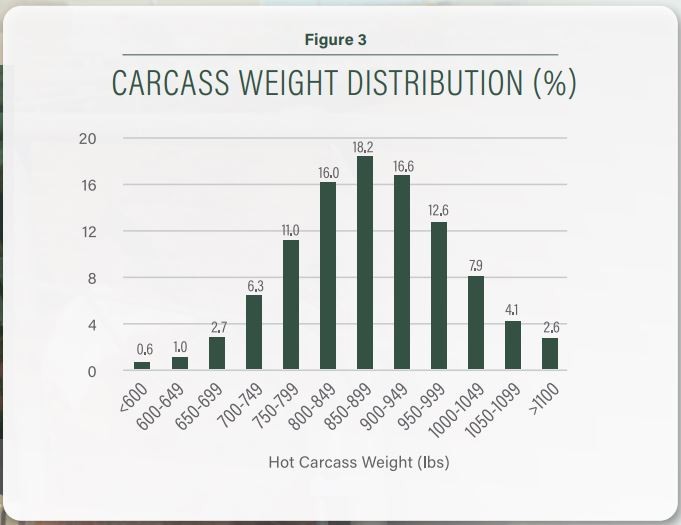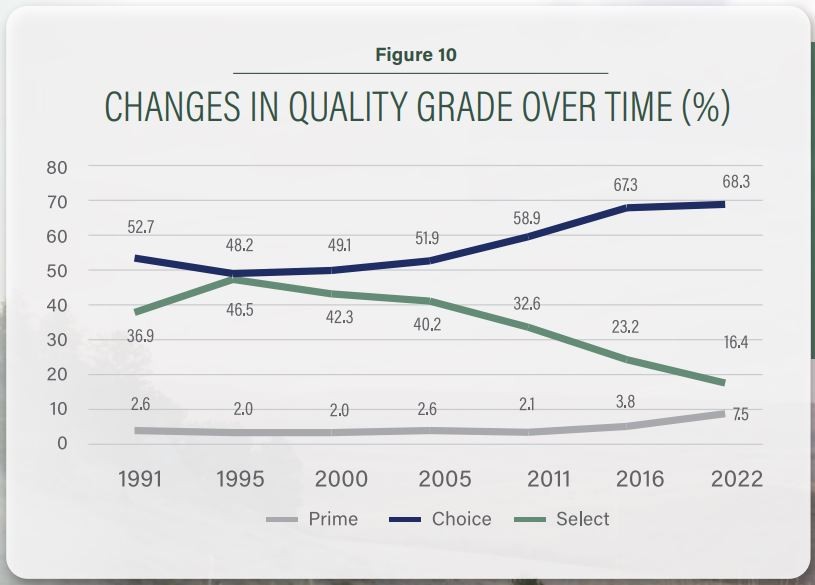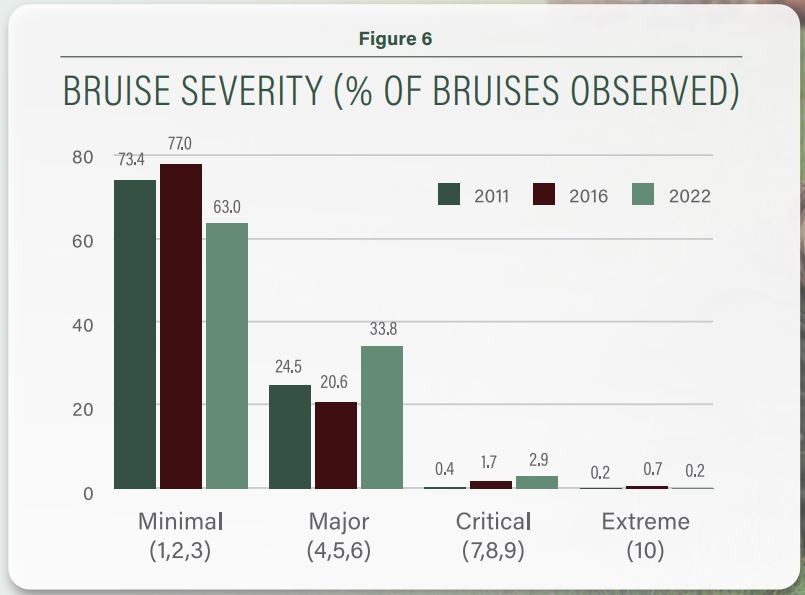2022 National Beef Quality Audit Results
Amy Barkley, Livestock Specialist
Southwest New York Dairy, Livestock and Field Crops Program
2022 National Beef Quality Audit Results
By Amy Barkley, Livestock Specialist, SWNYDLFC
Prior to the implementation of the Beef Quality Assurance (BQA) program, there were a high level of condemnations of beef carcasses at processing facilities. This data were quantified in 1991, with $11.99 billion lost in economic opportunities, with inefficiencies costing producers and processors $458/head. Consumers were unhappy with the inconsistencies of the beef on the shelves, while processors were frustrated with deep bruises and tissue lesions from injections. The results of these audits were the basis for the development of the Beef Quality Assurance Program.
The National Beef Quality Audit takes place every 5 years and serves as a check on the industry to ensure that beef quality is continually improving. The data points for this most recent analysis were collected in 2022, and results analyzed in 2023. Two groups of data were collected: One was from large industry buyers (abattoirs to retailers). The second was data on the cattle themselves. The whole country is represented in this analysis, with 30,000 animals evaluated and 130 buyers represented.
Buyers were asked questions about perceptions and progress made in the industry. In 2022, buyers noted that the biggest threat to the industry is environmental concerns and animal activism. This can be addressed by farms taking part in climate conscious rearing including precision feeding and waste management. Animal activism can’t be prevented, but farms can make sure they are doing the best for their animals while always being on the lookout for suspicious people and limit outsiders’ ability to access their livestock. Over 50% of companies interviewed for this audit believe that animal handling encompasses the majority of animal well-being.
Quality of the nation’s fed cattle is the best it’s ever been. When looking at carcass traits, the average yield grade is now 3.3 vs 3.1 a year ago, where the increase means that animals are fattier than they were, but are more lightly muscled. This may be caused by finishing operations chasing the prime market. There was an increase in the number of prime and choice animals and corresponding marbling scores in 2022 vs 2016. Whole animals are now larger, as evidenced by hot carcass weights and bigger ribeye areas.

While more cattle are achieving higher quality grades (choice and prime), the increased fat thickness comes with an increase in hot carcass weight and worse yield grades (more 4s and 5s, where 3 is an animal that balances fat and muscle). Click to enlarge.

There was an increase in Choice and Prime grades, while Select decreased. This corresponds with the increase in both marbling and yield grade. Click to enlarge.
While there is more trim loss from fattier animals, the industry as a whole is doing a better job of recapturing some of its profit opportunities. Using 2022 pricing, there has been improvement overall from 1991 to today of $23.16 per animal, but from 2016 to 2022, there was a decrease in profit per animal of $11.33 per animal. This was caused in part by fewer animals making quality grade (not enough marbling) or yield grade (animals are too large). Gains were made from improved carcass weights. The loss in quality grade isn’t because cattle aren’t meeting high choice and prime (they are!) it’s just that this number is calculated from a target quality goal, which is a goalpost that moves to a higher percentage at each audit. In 2017, the prime goal was 7.5% of all fed cattle. For the upcoming audit the prime goal will be 10%.
Unfortunately, some decreases in welfare were noted. There were 5% more animals that had issues either walking with limps or obvious discomfort as compared with 2016. This is attributed to larger cattle moving through the system and longer transportation times. Additionally, there was a 13.4% increase in the number of carcasses with bruising. Of those bruises, there was an increase in both major and critical bruising, decreasing minimal bruising (the mildest category) to 63% from 77%. There is a 1-10 pound cut loss for major bruises and greater than 10 pound loss for critical ones. Bruising is the highest it’s been since the audits began.

Bruise scores indicate the amount of tissue that is damaged and must be removed. Minimal bruising results in less than a pound of surface trim loss. Major is a loss of 1-10 pounds. Critical is more than 10 pounds of trim loss. Extreme is an injury so severe that the whole primal is lost. Over 50% of the carcasses surveyed were bruised. Click to enlarge.
What can producers do to improve their animal well-being and reduce losses from bruising? Decreasing the presence of horns in a herd, separating cattle by sex during transport, trailer design, cattle handling, and loading procedures can be all be addressed to help. At the time of this survey, the maximum space allotted per animal on a trailer was 12.5 sq ft, but the minimum was 6.3 sq ft. BQA recommends 10 sq ft per 1,000 pounds of animal, so the tight quarters found in this survey is likely one of the causes of increased bruising. That said, the positives found are that there is a trend in the number of trailer loads of cattle offering the appropriate amount of space, and no cattle in the survey were hauled longer than 24 hours in a stretch. Haulers can attain their BQAT certification, which is a BQA training designed for those who haul cattle. This training goes through managing cattle through the transportation process to preserve quality.
To conclude, the past 6 years had some pros and cons. What’s been made apparent is that there is still consumer loyalty and trust in the beef industry. However, with ever decreasing margins, farmers and transporters need to ensure the quality of their cattle from rearing to transport to ensure that they are getting the most out of their loads.
This article is based on information shared in the presentation by Michaela Clowser, Director of Producer Education at NCBA, on October 4, 2023. To listen to the original recording, visit https://www.youtube.com/watch?v=R4nxxhL-o6g&ab_channel=NewYorkBeefQualityAssurance All images were taken from the 2022 NBQA Quality Audit Executive Summary, which you can find here: 143783_nbqa_executive-summary-2022_prf_low-res.pdf
Upcoming Events
Cover Crop Breeding Field Walk
May 1, 2024
Freeville, NY
You're invited to join us for a Cover Crop Breeding Field Walk!
The Cover Crop Breeding Network breeds fall-sown cover crops for traits like fall emergence, winter survival, spring vigor, high biomass, hard seed, and non-shattering pods
Join us to walk the trial fields, talk about what we're seeing (and not seeing), hear about past years' results, and learn about CCB lines approaching commercialization.
Advanced line trials - Crimson clover, hairy vetch, winter pea, and winter canola
Planting date trials - Cereal rye and winter pea
Breeding nurseries - Cereal rye and winter pea (across the road & optional!)
Meat Your Farmer 2024
May 2, 2024 : Meat Your Farmer 2024
East Aurora, NY
This event brings together livestock farmers and the community to learn about local bulk meat sales and to taste recipes created for NYS schools, featuring meats from local farms. We are currently looking for farmers to participate in the event!
Western NY Value-Added Dairy Discussion Group: Jess May- Farm Credit East Webinar
May 2, 2024
We will start our Value-Added Dairy Processing discussion group series with a guest speaker from Farm Credit East. On May 2nd at noon, Jess May will join us to discuss the lender's point of view for on-farm processing and diversification. This is free to join and will be recorded.
Announcements
No announcements at this time.





